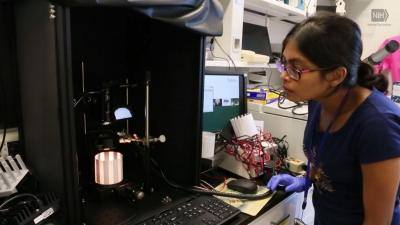
The eye is more than a window to the soul; it is a window to the brain. To highlight the important connection between vision science and neuroscience, the NIH’s National Eye Institute is kicking off its 50th anniversary celebration with the symposium “Vision and the Brain,” Friday, November 10, 2017, at the Marriott Marquis in Washington, D.C. The event takes place in conjunction with the annual meeting of the Society for Neuroscience and is the first in series of symposia scheduled through 2018.
“We are proud of the progress made in diagnosing and treating eye diseases and vision impairment since Congress established the NEI in 1968,” said NEI Director Paul A. Sieving, M.D., Ph.D. “Yet vision neuroscientists still seek to understand how the brain processes the visual information that floods our eyes, how neural activity is related to visual perception, and how the visual system interacts with cognitive and motor systems.”
Presenters at the symposium will discuss topics such as eye movement and visual pathways, the role of vision in decision making, and other aspects of research showing the contribution of visual systems neuroscience to action, perception, and cognition. Attendees can expect to get overviews and context, in an organized and understandable way, that connect the latest papers to past, present, and future research and treatments.
Featured talks:
- Michael Goldberg, Columbia University, “Attention and Arousal in Parietal Cortex”
- Dora Angelaki, Baylor College of Medicine, “Dynamics of Eye Movements During Visual Path Integration”
- Michele Basso, University of California Los Angeles, “The Role of the Basal Ganglia – Superior Colliculus Circuit in Determining Decision Making”
- Okihide Hikosaka, National Eye Institute, “Emotional History in the Substantia Nigra”
- William Newsome, Stanford University, “Monitoring Covert Visual Decisions Via Neural Population Dynamics in Frontal Cortex”
- Marlene Cohen, University of Pittsburgh, “Neuronal Population Coding: From Vision to Decision”
- Nicole Rust, University of Pennsylvania, “From Motion to Memory”
- Tony Movshon, New York University, “Cascaded Cortical Computation”
- Eric Kandel, Columbia University, “Memory and Age-related Memory Loss”
For the complete program, visit https://nei.nih.gov/50th-anniversary-symposium-vision-and-brain. Media interested in attending should email NEInews@nei.nih.gov.
Additionally, three symposia will take place on the NIH campus in 2018:
- Vision and Immunology, March 22
- Vision Rehabilitation, June 29
- the Future of Vision Research, October 18

Two new videos are at https://www.youtube.com/user/neinih/videos
NEI is also releasing a video series to commemorate its 50th anniversary. The first two videos, “NEI, Leading the Fight Against Blindness,” and “The Windows to Your Health,” are available now. Another two videos will follow later this year.
For more on NEI 50th Anniversary activities, visit https://nei.nih.gov/NEIat50.
###
NEI leads the federal government’s research on the visual system and eye diseases. NEI supports basic and clinical science programs to develop sight-saving treatments and address special needs of people with vision loss. For more information, visit https://www.nei.nih.gov.
About the National Institutes of Health (NIH): NIH, the nation’s medical research agency, includes 27 Institutes and Centers and is a component of the U.S. Department of Health and Human Services. NIH is the primary federal agency conducting and supporting basic, clinical, and translational medical research, and is investigating the causes, treatments, and cures for both common and rare diseases. For more information about NIH and its programs, visit http://www.nih.gov/.
NIH…Turning Discovery Into Health®